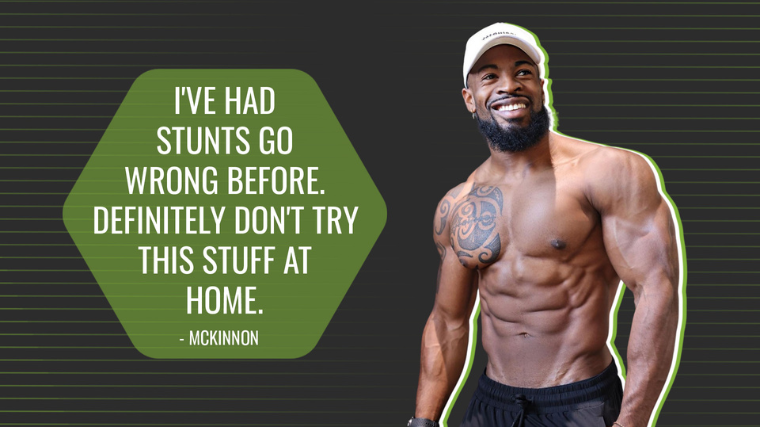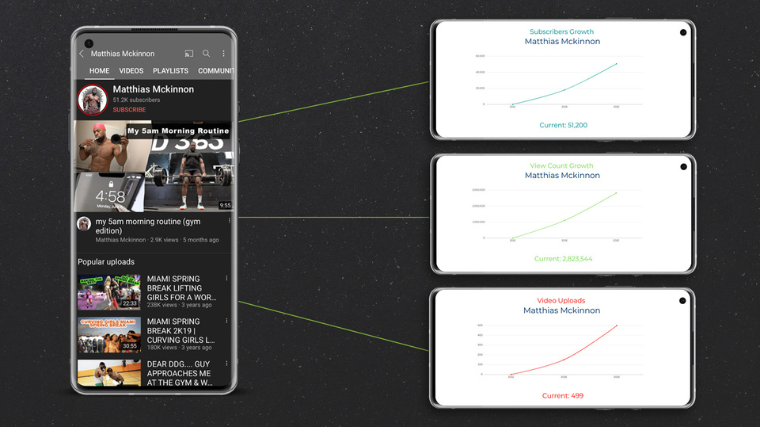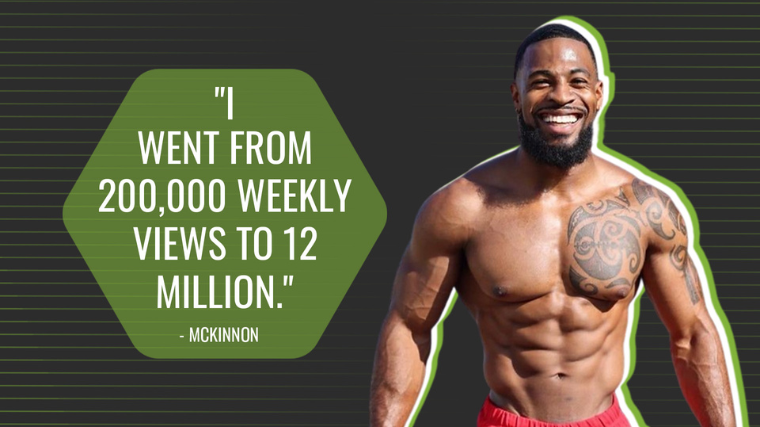If you happen to go to the same gym as Matthias McKinnon, you’re probably not used to your workouts going according to plan all the time.
After all, when you stride into the weight room for leg day and see McKinnon performing muscle-ups in the squat rack with a full-sized weight bench dangling from his belt, what are you supposed to do?
“Hey, man, mind if I work in?”
McKinnon is a modern-day muscle magician; a content creator in the fitness industry. His brand is also lightyears removed from how weight training on the Internet got off the ground at around the same time Apple unveiled the first iPhone.

What began as humble bench press tutorials on YouTube has since morphed into a tooth-and-nail fight for online stardom. While the entertainment value of ludicrously impressive gym stunts may speak for itself, what does it all mean for the consumers, and curators, of fitness content on social media?
Are “gymfluencers” using the power of the algorithm to endorse a healthy lifestyle, or are they racing to the bottom of the barrel?
Identifying Influence
Escalation is the state of play on social media. Consumers who scroll, swipe, and surf their way across Instagram, YouTube, and TikTok pass judgment on what they see in the blink of an eye.
Meta, the parent company of Facebook and Instagram, acknowledges that its users can decide whether or not a video is worth watching in as little as 1.7 seconds.
This forces aspiring internet celebrities to push themselves if they want to stand out. The barbells have to be heavier, the muscles bigger, and the lifting itself occasionally bordering on preposterous.
A YouTube video with millions of views in the 2000s was nothing to balk at. But today, numbers like that are par for the course for high-performing fitness influencers like McKinnon.
“I went from 200,000 weekly views to as many as 12 million. Doing the muscle-ups with a bench really started the blow-up for me. I’m trying to get as much exposure as possible,” he tells BarBend, describing what it takes to catch the current.
McKinnon is one of many individuals who have turned their gyms into playgrounds as a means of attracting subscribers and sponsorships: Creator and powerlifter Mike O’Brien (@mikeymaybeme) regularly posts his garage gym workouts to Instagram.
O’Brien’s exercises of choice include the “Safety Squat Bar Jug Swinging Shoe Salesman Bench Press Spotter Marriage Counselor Grip Ornament Landline Telephone Weighted Olympic Barbell-Supported Chair-Loaded Trap Bar Deadlift.”
It’s aptly named and likely weighs somewhere in the realm of 600 pounds.
Influencers like McKinnon and O’Brien may look like agents of chaos at first, but modern content creators are often quite calculated and precise about what they show to the world in the weight room. After all, you have to have something worth watching if you want to hold the gaze of the rapidly scrolling masses.
By and large, what you see on screen or in-app from the stuntmen and women of social media is what you get. There’s no sleight of hand behind Russian weightlifter Dmitry Klokov push-pressing two adult women on a Dubai beachfront.
McKinnon notes that his stunts are, for the most part, easier than the physical toll his former career in professional football took on his body. That said, they’re no walk in the park either.
“These antics are actually similar to the sport of strongman, where the athletes lift a lot of heavy non-barbell objects,” Dr. Pat Davidson, Ph.D. in Exercise Physiology and strength coach, says. “There’s a learning curve to working with any implement, but all training adheres to a few fundamental principles.”
McKinnon’s muscle-up video probably wasn’t his first-ever attempt at the movement. Focused rehearsals and reasonable progressions help influencers bridge the gap between foolhardy and phenomenal; before you can do a muscle-up, you need to be able to bang out several high-quality pull-ups. Before that, you need the back strength for a more remedial exercise like the inverted row.
Content creators in the fitness space deconstruct, amplify, and occasionally poke fun at these parameters, raking in millions of views (and dollars) in the process.
The Price (and Profit) of Growth On Social Media
In the roughly eight months since McKinnon published his muscle-up video, it’s racked up over two million page views on Instagram alone.
“I’ve been contacted by all kinds of mainstream media, from reality shows to ESPN,” McKinnon says. “The more views I get, the more profitable it is. I’m trying to get on the level of guys like Bradley Martyn.”
(Martyn maintains a combined social media following of nearly eight million. He posts videos of himself on a yacht squatting several adult women dangling off a barbell, treadmill sprints in the middle of a busy highway, and much more.)
Regularly pumping out bigger and better content isn’t just about setting yourself up for fame. It’s critical if you want to make a fortune in fitness.
There’s a lot of money in online coaching.
Some stunts may be as exhilarating to perform as they are to see on your smartphone, but fun doesn’t pay the bills for a content creator.
Influencers often use their content as a conduit to channel their following toward other revenue streams. Think of everything from discount codes for nutritional supplements to template workout programs, apparel, or online coaching — some of which can be extremely lucrative if marketed effectively.
According to SocialBlade, which tracks and analyzes social media metrics, aspiring physique athlete Levi Mack is estimated to make about $400 monthly from social media engagement.
Note that SocialBlade’s estimations for revenue are based on YouTube’s public API. The site strictly acknowledges that their estimations are “not supposed to be read as religion.”
However, Mack revealed in a YouTube vlog (above) to his 18,000-follower fanbase that, through partnerships and affiliate deals, he can bring in over $5,000 monthly.
“There’s a lot of money in online coaching,” Mack notes in the video.
If only 20 people out of his 50,000-ish following — less than one-tenth of a percent — on Instagram enrolled with him for online personal training at a rate of $250 a month, he’d comfortably double his income.
And Mack is miles from the top of the totem pole. Jeff Nippard, an industry leader focusing on educational content and lifestyle blogging, has a YouTube following of 3.5 million (with another 850,000 or so following his Instagram @jeffnippard) as of Dec. 2022.

SocialBlade estimates Nippard earns as much as $20,000 monthly as a creator.
Nippard also sells pre-written training plans on his website for about $50. Going by some light napkin math, if even one-tenth of a percent of his multi-million YouTube following purchased his latest release, Nippard stands to gross as much as $100,000.
But before Nippard can get a program into a viewer’s shopping cart or Mack can enroll a new client, they have to get that person to view their content in the first place.
The Flaws of Internet Fitness Fame
Thanks to the internet, consumers have access to more fitness-related information than they could wrap their heads around in a lifetime.
Unfortunately, consumers also have access to more fitness-related information than they could wrap their heads around in a lifetime. Content gluttony is just one of many problems with the expanding ecosystem of online exercise entertainment.

Make no mistake, McKinnon and many other influencers may not have have nefarious intent when they embark on building their brands and businesses. However, there’s a distinct lack of objective supervision on social media. The ease with which many consumers form parasocial relationships with influencers can also muddy the waters — you don’t really know them, but if you watch their vlogs weekly, it kind of feels like you do.
No Regulation, No Oversight
Social media platforms like Instagram have extensive systems in place to vet scientific or political rhetoric. However, they will permit the publication of misleading content in some cases if the “public interest outweighs the risk of harm.”
There’s certainly rampant public interest in health and fitness, but few in-app safeguards exist to light your way if you use Instagram to figure out which workout routine will help you shed a few pounds.
(Platforms like Instagram and TikTok do moderate user search behavior for keywords like #thinspo that have been linked to disordered eating behaviors or self-harm, but they don’t seem to supervise fitness content that banks on poor interpretations of scientific research or dubious supplement claims.)
Few in-app safeguards exist to light your way if you use Instagram for fitness advice.
Conversely, perceived legitimacy on social media is often tied to phenomena like “electronic word-of-mouth,” where users are more likely to accept certain advice as factual if they see it repeated by several different creators. (1)
The burden is placed on the users to conduct due diligence on what they’re consuming, while those putting out the content are also often the only ones verifying its quality.
It’s Not a Meritocracy
Instagram, TikTok, YouTube, and other social media platforms churn and sort through content based on extraordinarily complex algorithms. Although they operate based on user input behavior, that doesn’t always correlate with putting the best content at the top of your Explore feed.

The conflation of style and substance can be a pain point for some creators. Team USA Olympic lifter Hunter Elam (who has a following of almost 200,000 on Instagram) notes that it can be hard to legitimize an online business in the current climate, even if she has the credentials to back it up.
Many prominent content creators maintain certifications from groups like the American College of Sports Medicine (ACSM) or the American Council on Exercise (ACE). Still, formal accreditation doesn’t necessarily confer more views, comments, or clicks.
No Stunt Is Truly Safe
Most seasoned gymgoers would know better than to attempt the kind of stunts that McKinnon and his contemporaries knock out on the daily. Still, McKinnon can’t fully control who watches his content, nor does he put a disclaimer in front of every video:
“I’ve had stunts go wrong before. I’ve also seen a few guys try to do what I do,” he says. “Really, it’s all for entertainment and meant to inspire people. You don’t have to actually do these lifts to get motivated to go to the gym, so definitely don’t try this stuff at home.”
Dr. Davidson offers that most hyper-fit influencers probably didn’t build their physiques by performing the stunts they publish, and he’s at least partially right — McKinnon’s day-in, day-out exercise regime isn’t chock-full of absurdist weight room performances.
He blends standard bodybuilding training with pre-written CrossFit programming from five-time Fittest Man on Earth® Mat Fraser‘s Hard Work Pays Off group.
It’s wise for influencers to practice these movements before filming them for publication.
And even if a video on your Explore feed looks random or impromptu, there’s a good chance that the performer put a great deal of thought into its design.
“If you’re squatting with a set of bleachers on your back, you’ll get better at it with practice. It’s wise for influencers to practice their movements before filming them for publication,” Dr. Davidson says. For younger viewers or those not particularly well-informed, it can be all too easy to conflate an athletic performance intended as entertainment as something integral to, or achievable with, fitness as a whole.
Moreover, new gymgoers may find themselves paralyzed by having to sift through a mountain of catchy content to find what they’re after: The TikTok or Reel with the flashiest thumbnail may not necessarily have the highest-quality information, and different instructors can have wildly different approaches to teaching the same concept or exercise.
All Press Is Good Press
Modern social media algorithms take the old adage “any press is good press” and dial it up to 11.
In an Aug. 25, 2022 episode of The Joe Rogan Experience, Meta founder Mark Zuckerberg admitted that the predatory nature of modern social media algorithms is a feature, not a bug, meant to accommodate what viewers want to see as quickly and conveniently as possible.
“[The algorithm] is different now than it was a decade ago. The content hinges on the hook more than the substance itself,” long-time lifting YouTuber Omar Isuf said in a Sept. 19, 2022 vlog.
For example, YouTube’s algorithm loves when viewers watch a video from start to finish. For creators, that simplifies things. Shorter videos are more likely to be watched in full than longer ones. Your content doesn’t necessarily need to be well-informed or thoroughly cross-referenced to go viral. It has to be sticky.
Person-to-person, these problems may not amount to much. Most users likely glance at a stunt, chuckle or share it with their friends, and move on.

But for those who utilize Instagram and other platforms to learn and better themselves, limited oversight and vicious competition for viewership are just a few of the many mounting issues.
It’s pretty easy to find what you’re looking for, but determining quality is another matter altogether.
Fitness Moving Forward
Thanks to his weight bench muscle-up video, Matthias McKinnon finally feels like he can offer something to his fanbase other than more weight room shenanigans.
“I post what the internet likes to see; that’s what really drives my content,” he says. “But because I’ve been pulling in so much traffic, I feel like I can finally start posting my actual workouts.”
Despite being an “influencer,” McKinnon isn’t actually trying to convince you to strap yourself to a 70-pound-whatever and scale the squat rack in your local gym. Like many of his contemporaries, he wants to motivate people. But before a creator can inspire someone to hit the gym and improve their health, they’ve got to get their attention in the first place.

Shirtless stunts are how McKinnon and his colleagues choose to cut through the static on social media. A strategy that works, but not without some collateral damage along the way.
From the 15-second Instagram Story to TikTok and even YouTube Shorts (how the tables have turned), the format and presentation of social media content in 2022 demands — and usually rewards — brevity and cleverness over verbosity and nuance.
It’s more perilous than practical to try to explain concepts like training periodization, nutrient partitioning, or how to prep for a powerlifting meet in a minute or less. But flash and finesse are what the creators on your favorite platform are encouraged to serve, and it’s what millions of users are gobbling up at the speed of light.
References
1. Mena, P., Barbe, D., & Chan-Olmsted, S. (2020). Misinformation on Instagram: The Impact of Trusted Endorsements on Message Credibility. Social Media + Society, 6(2).
Featured Image: @matthias_mckinnon on Instagram, Jordan Sanders on Facebook